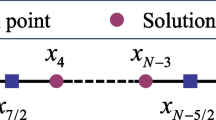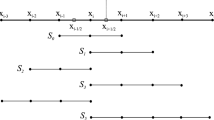Abstract
High-order compact interpolation schemes appropriate for multiscale flows are studied within a cell-centered finite difference method (CCFDM) framework where the robustness of high-order schemes on curvilinear grids can be greatly enhanced due to the satisfaction of geometric conservation law. Two types of compact interpolations are mainly developed in this paper for shock-free flows and shock-embedded flows respectively. The present compact schemes are verified to be superior over the explicit counterparts with same orders in terms of the spectral characteristics. Regarding the shock-free flows, low-dissipation low-dispersion properties are achieved by the spectral optimization. Three optimized compact schemes (Opt4, Opt6 and Opt8) are further validated to be attractive for shock-free problems by carrying out benchmarks from computational aeroacoustics workshops and two typical turbulence cases: Tayler–Green vortex and decaying isotropic turbulence. Regarding high-speed flows in the presence of shock waves, the shock-capturing capability is realized by extending the weighting technique to the compact interpolations. The criteria to choose optimally compact nonlinear sub-stencils on a most general compact global stencil are presented. Interestingly, the explicit WENO-type schemes can be reverted within the proposed compact framework. Three nonlinear compact schemes (UI5, CI6 and CI8) on two practical stencils are analyzed and further compared with their explicit counterparts by a series of numerical experiments. The compact ones are superior to explicit ones in resolving rich flow structures as well as discontinuities.





























Similar content being viewed by others
References
Ekaterinaris, J.A.: High-order accurate, low numerical diffusion methods for aerodynamics. Prog. Aerosp. Sci. 41, 192–300 (2005). https://doi.org/10.1016/j.paerosci.2005.03.003
Wang, Z.J.: High-order methods for the Euler and Navier–Stokes equations on unstructured grids. Prog. Aerosp. Sci. 43, 1–41 (2007). https://doi.org/10.1016/j.paerosci.2007.05.001
Deng, X., Mao, M., Tu, G., Zhang, H., Zhang, Y.: High-order and high accurate CFD methods and their applications for complex grid problems. Commun. Comput. Phys. 11, 1081–1102 (2012). https://doi.org/10.4208/cicp.100510.150511s
Lele, S.K.: Compact finite difference schemes with spectral-like resolution. J. Comput. Phys. 103, 16–42 (1992). https://doi.org/10.1016/0021-9991(92)90324-R
Visbal, M.R., Gaitonde, D.V.: Very high-order spatially implicit schemes for computational acoustics on curvilinear meshes. J. Comput. Acoust. 09, 1259–1286 (2001). https://doi.org/10.1142/S0218396X01000541
Kim, J.W., Lee, D.J.: Optimized compact finite difference schemes with maximum resolution. AIAA J. 34, 887–893 (1996). https://doi.org/10.2514/3.13164
Kim, J.W.: Optimised boundary compact finite difference schemes for computational aeroacoustics. J. Comput. Phys. 225, 995–1019 (2007). https://doi.org/10.1016/j.jcp.2007.01.008
Nagarajan, S., Lele, S.K., Ferziger, J.H.: A robust high-order compact method for large eddy simulation. J. Comput. Phys. (2003). https://doi.org/10.1016/S0021-9991(03)00322-X
Fu, D., Ma, Y.: A high order accurate difference scheme for complex flow fields. J. Comput. Phys. 134, 1–15 (1997). https://doi.org/10.1006/jcph.1996.5492
Fan, P.: The standard upwind compact difference schemes for incompressible flow simulations. J. Comput. Phys. 322, 74–112 (2016). https://doi.org/10.1016/j.jcp.2016.06.030
Zhong, X.: High-order finite-difference schemes for numerical simulation of hypersonic boundary-layer transition. J. Comput. Phys. 144, 662–709 (1998). https://doi.org/10.1006/jcph.1998.6010
Bhumkar, Y.G., Sheu, T.W.H., Sengupta, T.K.: A dispersion relation preserving optimized upwind compact difference scheme for high accuracy flow simulations. J. Comput. Phys. 278, 378–399 (2014). https://doi.org/10.1016/j.jcp.2014.08.040
Sicot, F.: High order schemes on non-uniform structured meshes in a finite-volume formulation. Master Dissertation, Chalmers University of Technology (2006)
Broeckhoven, T., Smirnov, S., Ramboer, J., Lacor, C.: Finite volume formulation of compact upwind and central schemes with artificial selective damping. J. Sci. Comput. 21, 341–367 (2004). https://doi.org/10.1007/s10915-004-1321-6
Lacor, C., Smirnov, S., Baelmans, M.: A finite volume formulation of compact central schemes on arbitrary structured grids. J. Comput. Phys. 198, 535–566 (2004). https://doi.org/10.1016/j.jcp.2004.01.025
Johnsen, E., Larsson, J., Bhagatwala, A.V., Cabot, W.H., Moin, P., Olson, B.J., Rawat, P.S., Shankar, S.K., Sjögreen, B., Yee, H.C., Zhong, X., Lele, S.K.: Assessment of high-resolution methods for numerical simulations of compressible turbulence with shock waves. J. Comput. Phys. 229, 1213–1237 (2010). https://doi.org/10.1016/j.jcp.2009.10.028
Pirozzoli, S.: Numerical methods for high-speed flows. Annu. Rev. Fluid Mech. 43, 163–194 (2011). https://doi.org/10.1146/annurev-fluid-122109-160718
Jiang, G.-S., Shu, C.-W.: Efficient implementation of weighted ENO schemes. J. Comput. Phys. 126, 202–228 (1996). https://doi.org/10.1006/jcph.1996.0130
Adams, N.A., Shariff, K.: A high-resolution hybrid compact-ENO scheme for shock–turbulence interaction problems. J. Comput. Phys. 127, 27–51 (1996). https://doi.org/10.1006/jcph.1996.0156
Pirozzoli, S.: Conservative hybrid compact-WENO schemes for shock–turbulence interaction. J. Comput. Phys. 178, 81–117 (2002). https://doi.org/10.1006/jcph.2002.7021
Ren, Y.-X., Liu, M., Zhang, H.: A characteristic-wise hybrid compact-WENO scheme for solving hyperbolic conservation laws. J. Comput. Phys. 192, 365–386 (2003). https://doi.org/10.1016/j.jcp.2003.07.006
Ghosh, D., Baeder, J.D.: Compact reconstruction schemes with weighted ENO limiting for hyperbolic conservation laws. SIAM J. Sci. Comput. 34, A1678–A1706 (2012). https://doi.org/10.1137/110857659
Ghosh, D., Baeder, J.D.: Weighted non-linear compact schemes for the direct numerical simulation of compressible, turbulent flows. J. Sci. Comput. 61, 61–89 (2014). https://doi.org/10.1007/s10915-014-9818-0
Ghosh, D., Medida, S., Baeder, J.D.: Application of compact-reconstruction weighted essentially nonoscillatory schemes to compressible aerodynamic flows. AIAA J. 52, 1858–1870 (2014). https://doi.org/10.2514/1.J052654
Ghosh, D., Constantinescu, E.M., Brown, J.: Efficient implementation of nonlinear compact schemes on massively parallel platforms. SIAM J. Sci. Comput. 37, C354–C383 (2015). https://doi.org/10.1137/140989261
Thomas, P.D., Lombard, C.K.: Geometric conservation law and its application to flow computations on moving grids. AIAA J. 17, 1030–1037 (1979). https://doi.org/10.2514/3.61273
Shu, C.-W.: High order weighted essentially nonoscillatory schemes for convection dominated problems. SIAM Rev. 51, 82–126 (2009). https://doi.org/10.1137/070679065
Dumbser, M., Käser, M.: Arbitrary high order non-oscillatory finite volume schemes on unstructured meshes for linear hyperbolic systems. J. Comput. Phys. 221, 693–723 (2007). https://doi.org/10.1016/j.jcp.2006.06.043
Deng, X., Zhang, H.: Developing high-order weighted compact nonlinear schemes. J. Comput. Phys. 165, 22–44 (2000). https://doi.org/10.1006/jcph.2000.6594
Deng, X., Mao, M., Tu, G., Liu, H., Zhang, H.: Geometric conservation law and applications to high-order finite difference schemes with stationary grids. J. Comput. Phys. 230, 1100–1115 (2011). https://doi.org/10.1016/j.jcp.2010.10.028
Abe, Y., Nonomura, T., Iizuka, N., Fujii, K.: Geometric interpretations and spatial symmetry property of metrics in the conservative form for high-order finite-difference schemes on moving and deforming grids. J. Comput. Phys. 260, 163–203 (2014). https://doi.org/10.1016/j.jcp.2013.12.019
Nonomura, T., Iizuka, N., Fujii, K.: Freestream and vortex preservation properties of high-order WENO and WCNS on curvilinear grids. Comput. Fluids 39, 197–214 (2010). https://doi.org/10.1016/j.compfluid.2009.08.005
Zhu, Y., Sun, Z., Ren, Y., Hu, Y., Zhang, S.: A numerical strategy for freestream preservation of the high order weighted essentially non-oscillatory schemes on stationary curvilinear grids. J. Sci. Comput. 72, 1021–1048 (2017). https://doi.org/10.1007/s10915-017-0387-x
Liao, F., Ye, Z., Zhang, L.: Extending geometric conservation law to cell-centered finite difference methods on stationary grids. J. Comput. Phys. 284, 419–433 (2015). https://doi.org/10.1016/j.jcp.2014.12.040
Liao, F., Ye, Z.: Extending geometric conservation law to cell-centered finite difference methods on moving and deforming grids. J. Comput. Phys. 303, 212–221 (2015). https://doi.org/10.1016/j.jcp.2015.09.032
Liao, F., He, G.: High-order adapter schemes for cell-centered finite difference method. J. Comput. Phys. 403, 109090 (2020). https://doi.org/10.1016/j.jcp.2019.109090
Deng, X., Mao, M., Tu, G., Zhang, Y., Zhang, H.: Extending weighted compact nonlinear schemes to complex grids with characteristic-based interface conditions. AIAA J. 48, 2840–2851 (2010). https://doi.org/10.2514/1.J050285
Nonomura, T., Fujii, K.: Effects of difference scheme type in high-order weighted compact nonlinear schemes. J. Comput. Phys. 228, 3533–3539 (2009). https://doi.org/10.1016/j.jcp.2009.02.018
Deng, X., Jiang, Y., Mao, M., Liu, H., Li, S., Tu, G.: A family of hybrid cell-edge and cell-node dissipative compact schemes satisfying geometric conservation law. Comput. Fluids 116, 29–45 (2015). https://doi.org/10.1016/j.compfluid.2015.04.015
Yan, Z.-G., Liu, H., Ma, Y., Mao, M., Deng, X.: Further improvement of weighted compact nonlinear scheme using compact nonlinear interpolation. Comput. Fluids 156, 135–145 (2017). https://doi.org/10.1016/j.compfluid.2017.06.028
Subramaniam, A., Wong, M.L., Lele, S.K.: A high-order weighted compact high resolution scheme with boundary closures for compressible turbulent flows with shocks. J. Comput. Phys. 397, 108822 (2019). https://doi.org/10.1016/j.jcp.2019.07.021
Jin, Y., Liao, F., Cai, J.: Optimized low-dissipation and low-dispersion schemes for compressible flows. J. Comput. Phys. 371, 820–849 (2018). https://doi.org/10.1016/j.jcp.2018.05.049
Liu, X., Zhang, S., Zhang, H., Shu, C.-W.: A new class of central compact schemes with spectral-like resolution I: Linear schemes. J. Comput. Phys. 248, 235–256 (2013). https://doi.org/10.1016/j.jcp.2013.04.014
Tam, C.K.W., Webb, J.C.: Dispersion-relation-preserving finite difference schemes for computational acoustics. J. Comput. Phys. (1993). https://doi.org/10.1006/jcph.1993.1142
Martín, M.P., Taylor, E.M., Wu, M., Weirs, V.G.: A bandwidth-optimized WENO scheme for the effective direct numerical simulation of compressible turbulence. J. Comput. Phys. 220, 270–289 (2006). https://doi.org/10.1016/j.jcp.2006.05.009
Zhanxin, L., Qibai, H., Li, H., Jixuan, Y.: Optimized compact filtering schemes for computational aeroacoustics. Int. J. Numer. Methods Fluids 60, 827–845 (2009). https://doi.org/10.1002/fld.1914
Mullenix, N., Gaitonde, D.: A bandwidth and order optimized WENO interpolation scheme for compressible turbulent flows. In: 49th AIAA Aerospace Sciences Meeting including the New Horizons Forum and Aerospace Exposition. American Institute of Aeronautics and Astronautics, Reston, Virigina (2011)
Sun, Z., Luo, L., Ren, Y., Zhang, S.: A sixth order hybrid finite difference scheme based on the minimized dispersion and controllable dissipation technique. J. Comput. Phys. 270, 238–254 (2014). https://doi.org/10.1016/j.jcp.2014.03.052
Weirs, V., Candler, G., Weirs, V., Candler, G.: Optimization of weighted ENO schemes for DNS of compressible turbulence. In: 13th Computational Fluid Dynamics Conference. American Institute of Aeronautics and Astronautics, Reston, Virigina (1997)
Ahn, M.-H., Lee, D.J.: Supersonic jet noise prediction using optimized compact scheme with modified monotonicity preserving limiter. In: 2018 AIAA Aerospace Sciences Meeting. American Institute of Aeronautics and Astronautics, Reston, Virginia (2018)
Ha, C.-T., Lee, J.H.: A modified monotonicity-preserving high-order scheme with application to computation of multi-phase flows. Comput. Fluids 197, 104345 (2020). https://doi.org/10.1016/j.compfluid.2019.104345
Sumi, T., Kurotaki, T.: A new central compact finite difference formula for improving robustness in weighted compact nonlinear schemes. Comput. Fluids 123, 162–182 (2015). https://doi.org/10.1016/j.compfluid.2015.09.012
Pirozzoli, S.: On the spectral properties of shock-capturing schemes. J. Comput. Phys. 219, 489–497 (2006). https://doi.org/10.1016/j.jcp.2006.07.009
Blazek, J.: Computational Fluid Dynamics: Principles and Applications. Elsevier, Amsterdam (2015)
Hardin, J.C., Ristorcelli, J.R., Tam, C.K.W.: ICASE/LaRC workshop on benchmark problems in computational aeroacoustics (CAA). NASA-CP-3300 (1995)
Bodony, D.J.: Analysis of sponge zones for computational fluid mechanics. J. Comput. Phys. 212, 681–702 (2006). https://doi.org/10.1016/j.jcp.2005.07.014
Kim, J.W., Lee, D.J.: Fourth computational aeroacoustics (CAA) workshop on benchmark problems. NASA-CP-2004-212954 (2000)
Brachet, M.E., Meiron, D.I., Orszag, S.A., Nickel, B.G., Morf, R.H., Frisch, U.: Small-scale structure of the Taylor–Green vortex. J. Fluid Mech. 30, 411–452 (1983). https://doi.org/10.1017/S0022112083001159
Samtaney, R., Pullin, D.I., Kosović, B.: Direct numerical simulation of decaying compressible turbulence and shocklet statistics. Phys. Fluids 13, 1415–1430 (2001). https://doi.org/10.1063/1.1355682
Rogallo, R.S.: Numerical experiments in homogeneous turbulence. NASA-TM-81315 (1981)
Shi, J., Zhang, Y.-T., Shu, C.-W.: Resolution of high order WENO schemes for complicated flow structures. J. Comput. Phys. 186, 690–696 (2003). https://doi.org/10.1016/S0021-9991(03)00094-9
Inoue, O., Hattori, Y.: Sound generation by shock–vortex interactions. J. Fluid Mech. 380, 81–116 (1999). https://doi.org/10.1017/S0022112098003565
Acknowledgements
This research is financially supported by 111 Project of China (No. B17037), the National Natural Science Foundation of China (No. 91952203). We also thank the reviewers for their valuable comments which have substantially improved the quality of our manuscript.
Author information
Authors and Affiliations
Corresponding author
Additional information
Publisher's Note
Springer Nature remains neutral with regard to jurisdictional claims in published maps and institutional affiliations.
Appendices
Appendix A: Compact Interpolations
See Tables 11, 12, 13, 14 and 15.
Appendix B: Proof of Eq. (23)
Applying Taylor series analysis on Eq. (20) to achieve (2K + 2L)th-order accuracy, the following (2K + 2L) constraints are required:
where the column vectors C, X, Y and matrices A, B are

Using block multiplication of matrices, Eq. (49) is written in the following form:
There are (K + L) equations but (K + L + 1) unknowns in each equation of Eqs. (50) and (51), which means both Eqs. (50) and (51) are underdetermined. In Eq. (50), the first unknown element in \( X_{1} \) is \( \beta_{1} { + }\beta_{ - 1} \). Assuming \( \beta_{1} { + }\beta_{ - 1} = \eta \), all the entries in \( X_{1} \) and \( Y_{1} \) are dependent variables of \( \eta \). Similarly, in Eq. (51), the first unknown element in \( X_{2} \) is \( \beta_{1} - \beta_{ - 1} \). Assuming \( \beta_{1} - \beta_{ - 1} = \xi \), the other entries in \( X_{2} \) and \( Y_{2} \) are dependent variables of \( \xi \). These yield:
Rights and permissions
About this article
Cite this article
Jin, Y., Liao, F. & Cai, J. Compact Schemes for Multiscale Flows with Cell-Centered Finite Difference Method. J Sci Comput 85, 17 (2020). https://doi.org/10.1007/s10915-020-01314-w
Received:
Revised:
Accepted:
Published:
DOI: https://doi.org/10.1007/s10915-020-01314-w




